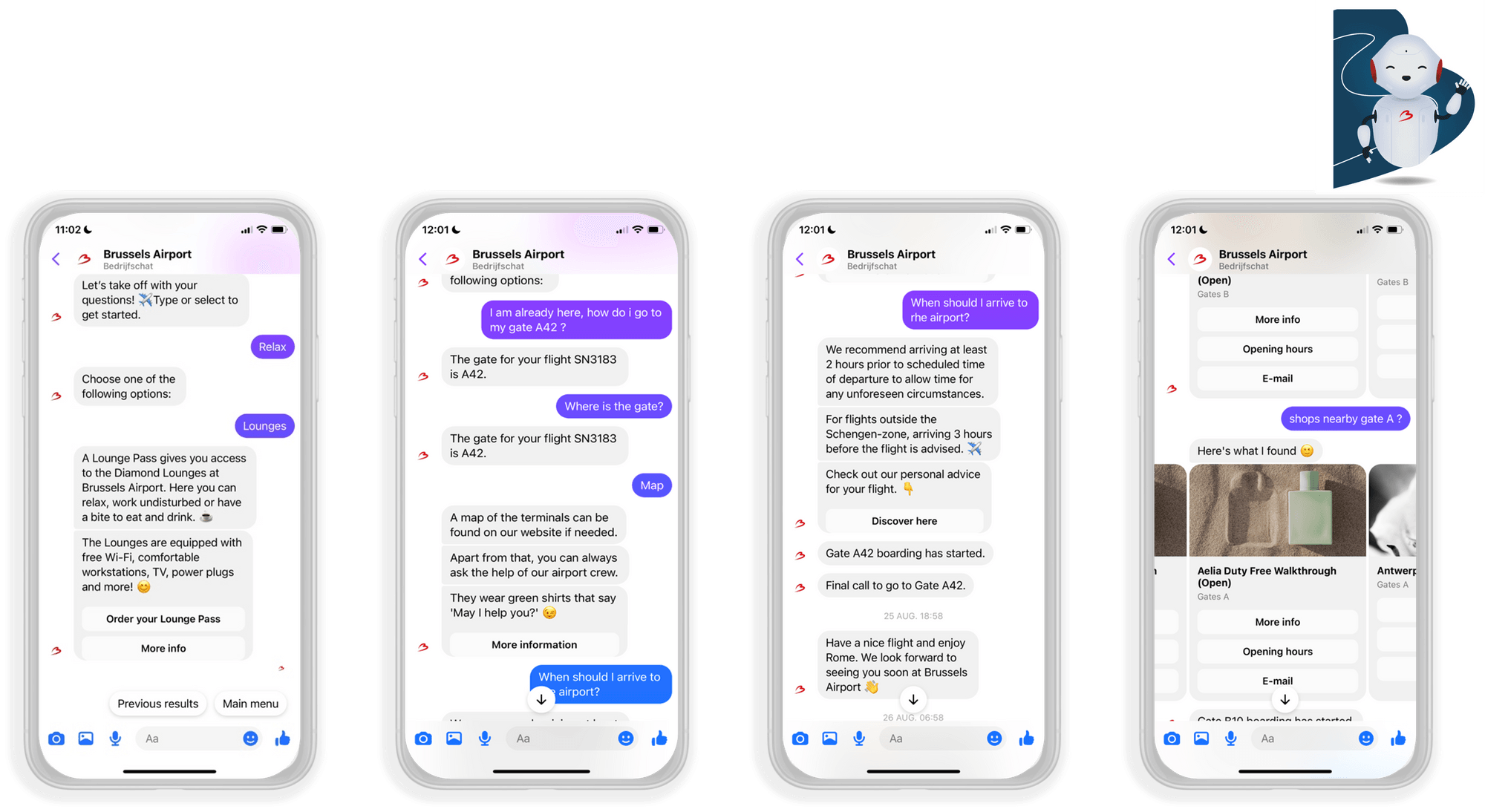After reading this article, you'll know more about:
- How Conversational AI Chatbots can benefit your business
- The potential challenges and how you can avoid them
- A few actionable tips to implement Chatbots
After reading this article, you'll know more about:

Example of BRUce, awarded as best chatbot of 2022
Chatbots aren’t just your typical business sidekicks anymore. Far cry from giving fixed responses, they can now mimic human conversations, engage customers beyond common queries, and improve the end-user experience without bounds. But how, you ask? Well, the credit goes to Conversational AI. This advanced technology is redefining how chatbots function, and what they can do. We got a taste of this while working on BRUce, the advanced chatbot at Brussels Airport, which takes the passenger travel experience to the next level. We worked closely on BRUce’s abilities, allowing the chatbot to personalize each traveller’s experience based on their top needs – with proactive suggestions, advanced interactions, and on-time assistance.
During this project, we uncovered the unlimited possibilities of conversational AI, and how it can completely revolutionize how businesses interact with their audiences. From live ticket resolving to hyper-personalization – the potentials are endless. And with further developments in AI, we’re looking at a business tool that’s not just a nice-to-have, but a necessity.
Simply put, conversational AI is the technology used in chatbots or other virtual agents to mimic human interactions and enable more engaging user interactions. It interprets varied user inputs and preferences, allowing a smoother experience. For example, with BRUce, we brought value to different passenger personas with personalized features and real-time support.
Behind conversational AI, there lie technological concepts like neural networks, machine learning, and natural language processing that work to run the advanced chatbot.
This technology is not to be confused with Generative AI, though. While conversational AI understands and responds to user inputs, generative AI creates unique, original content from the inputs fed into it. For now, chatbots mainly use conversational AI, but we may not be far from generative AI-powered chatbots.
Chatbots have been around for a while now. But conversational AI systems have changed how these chatbots interact and assist businesses. With live insights, easier integrations, and a flexible framework, they prove highly effective in optimizing workflows and resolving different customer issues. While working on BRUce, we uncovered the chatbot’s abilities to help Brussel’s Airport offer a next-gen passenger experience. From timely contextual messages to proactive passenger support, we could integrate BRUce seamlessly across multiple channels, creating a harmonized travel experience.
Given the evolving and flexible nature of the tech, chatbots working under conversational AI are a significant asset for multi-segmented businesses across industries. Let’s unpack a few of these direct business benefits:
1) Smoother Customer Experience
Packed with user-friendly functionalities, chatbots are a goldmine to improve the customer experience across your diverse user base. From resolving timely queries and offering instant assistance, conversational AI chatbots offer everything your customer needs. The best part? These chatbots don’t follow robotic scripts. They learn and develop, delivering relevant, human responses that engage audiences.
2) Anytime, Anywhere Support
The growing demand for exceptional customer service has set the bar high. Your users want to be helped 24/7. Chatbots are here to help you with this. They stay at your audience’s service, listening to any demand they might have, at any time. You can integrate the bot across business and social media channels like your website, WhatsApp, and Facebook Messenger among others. This helps you offer inclusive and holistic customer support that’s always active. In fact, these chatbots have the ability to hold a complete conversation, understand customer queries, and respond accordingly.
3) Improved Agent Efficiency
Solving simpler issues and handling common queries, conversational AI chatbots serve as your agent’s personal assistant and offer significant support in their tasks. They free up the live agent’s time, allowing them to focus on more dynamic and complex issues. For longer queries, the chatbot can hand off the ticket to a live agent, who now starts with greater context by accessing the pre-existing conversation thread.
While chatbots are a fascinating business tool, they’re not perfect. You’ll face security concerns, ethical considerations, and a general lack of empathy. The human touch is missing – especially in places where your customers will need human interaction. While conversational AI tech has been able to mimic human-like conversations, users still need that organic element.
To avoid such issues, it’s important to have a layer of human touch over the chatbots. Allowing users to escalate the issue to a live agent, creates a safety net for your customer experience, making them feel heard and cared for. Businesses should also consistently monitor AI’s evolving capabilities and improve the chatbot’s functionality over time. The tech is constantly getting smarter – which means your chatbot can evolve with time and offer a greater experience as it goes.
By 2023, chatbots are expected to save a total of five billion man-hours. AI technology is evolving rapidly, growing smarter with every development. Many tech giants are investing time and effort to build advanced AI chatbots, expanding their functionalities to offer extraordinary customer service.
Hyper-personalization – Further developments in the tech are aiming toward understanding real-time user preferences and personas, allowing for hyper-personalized communications with a human touch. Think multilingual conversations, instance and intent-based suggestions, and more.
Integration with Other Tech – For greater functionality and usability, Conversational AI will possibly integrate with Generative AI tech and virtual reality platforms. The combined system will take user engagement to new heights.
Sentiment Analytics – As the interpretation technology advances, conversational AI could evolve to analyse user emotions and sentiments and deliver responses based on the user’s mood. This could make the conversations more empathetic and personal.
While they simplify your business aspects, chatbots are a complicated tool. Working up close on BRUce, we’ve learnt a few factors that businesses should consider with their chatbots – from privacy concerns to investigating user needs. For starters, businesses should identify their pain point, whether at customer interactions or internal processes and assess how chatbots could benefit them. It gives the chatbot a definite mission, allowing you to quantify and manage its efficiency. Next, chatbots should be built with the target user in mind. What they need, how they interact, and their preferences – the chatbots should be built to understand it all, establishing a personal connection with the user. This is exactly what we did with BRUce. Armed with a field research study, we mapped different personas and enabled BRUce to assist with user-specific needs at the right time.
Conversational AI is not just the future, it's now. The tech has taken chatbots to a new level of functionality, personalization, and interaction. Live agent’s activities have become more profitable and ticket resolutions are a breeze. Even multi-segmented businesses with a diverse user base can offer personalized attention to their audiences.
But the future still has a lot in store. The constant developments in AI open up a sea of exciting possibilities in the coming years. We’re looking at a chatbot system that goes beyond effective customer experiences, improving the business workflow, facilitating inter-department interaction, and creating a streamlined ecosystem across the organisation.

Michiel Baets
Partner
Want to stay in the loop with our upcoming content?
Read a little more about us